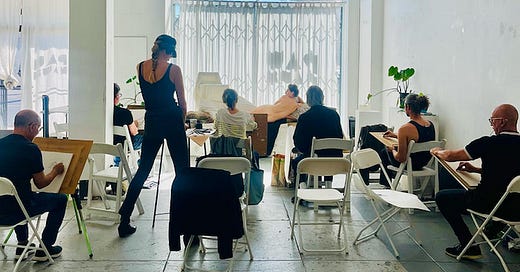
What: Melrose Drawing Club, an uninstructed figure drawing class
Who: Hosted by Pauhaus Gallery founder and artist Paulene Aguirre
When: Meets Sundays from 11 a.m to 2 p.m. and Thursdays from 7 p.m. to 10 p.m.
Where: Pauhaus Gallery, 5239 Melrose Ave, Los Angeles
How: $25, includes snacks and beverages; artists bring their own supplies
Why: The first thing you should know is that I can’t draw—at all. Luckily, at the Melrose Drawing Club, artistic talent, or lack thereof, doesn’t matter. So, on a recent Sunday morning, I headed to Pauhaus Gallery in Los Angeles for an uninstructed figure drawing class. The twice-a-week class—it meets Sundays from 11 a.m. to 2 p.m. and Thursdays from 7 p.m. to 10 p.m.—is hosted by Pauhaus founder and artist Paulene “Pau” Aguirre. Once there, I paid the $25 entry fee, which includes snacks and beverages, like coffee. As required, I’d brought my own art supplies. A few days prior, I’d bought drawing tools and a large pad of paper at an art store.
In the light-filled loft space of the gallery, I took a seat on a folding chair along with the dozen or so others who had gathered for the class. The attendees ranged from younger to older, the casual artist to the expert artist, and while there were more men than women, I was one of a handful of women. Apparently, the scheduled model had cancelled at the last minute. If Pau couldn’t find another model, she had planned to model herself. But a replacement model had been secured. Eventually, the model arrived. At the front of the room, the model removed her chartreuse negligee. Fully nude, she struck a pose atop a faux fur blanket draped over a box on the elevated stage. As the music played, we bent over our work and got to drawing.
First, the model assumed ten different poses which she held for one minute each. She turned away and looked over her shoulder. She reclined backwards over the box. She sat down and placed her hand behind her head. After that, she assumed five poses for five minutes each. As she posed, we drew, scribbled, and sketched. One artist was using charcoal. Another artist was using a digital pad. Yet another artist was using crayons. When it was time for a break, the model put on her negligee. As the attendees drank coffee and ate cookies, the model moved around the room, complimenting the artists on their renderings of her. When the break was over, she stripped again. Three poses of ten minutes each followed.
Over the course of the class, my drawings didn’t get any better. Or maybe they did. Either way, it started to not matter. I stopped worrying about whether or not my art sucked and began experimenting with charcoal pencils, gel sticks, crayons. At the halfway point, I noticed the group seemed to have entered into a collective flow. Like the model’s clothes, judgement had fallen away. The nudity was secondary. Art was primary. The point wasn’t what you were creating but that you were there at all.
Thanks for reading The Reverse Cowgirl! If you enjoyed this, please subscribe, like, or share my newsletter. You can learn more about me, work with me through The Fixer, or buy my book. Let’s connect on X, Instagram, Threads, Bluesky, Facebook, and LinkedIn.




This reminds me of when I was about 21 years old. I came from an artistic family but was living in a very conservative community, it still is.
My older brother was a Motörhead, we’d met a driver/owner and had become crew members on an international formula race car team. The owner-driver was a commercial graphic illustrator with an art degree of St. Louis University. I was a photographer for my college publications and freelancing at the time.
One day I was talking about how I thought my college was putting its arts major students at a dsadvantage because, as a catholic school, there were no figure studies classes. I must’ve remarked I found the idea somewhat erotic too.
Tom, our driver, remarked to me; “When I had to take figures class on the first day when she disrobed I thought this is wonderful it can’t be happening! Then in the days following that feeling completely went away. It became the struggle to do her justice and express myself on paper and canvas. Then, for the rest of college nude models and figure studies were just another part of the job”